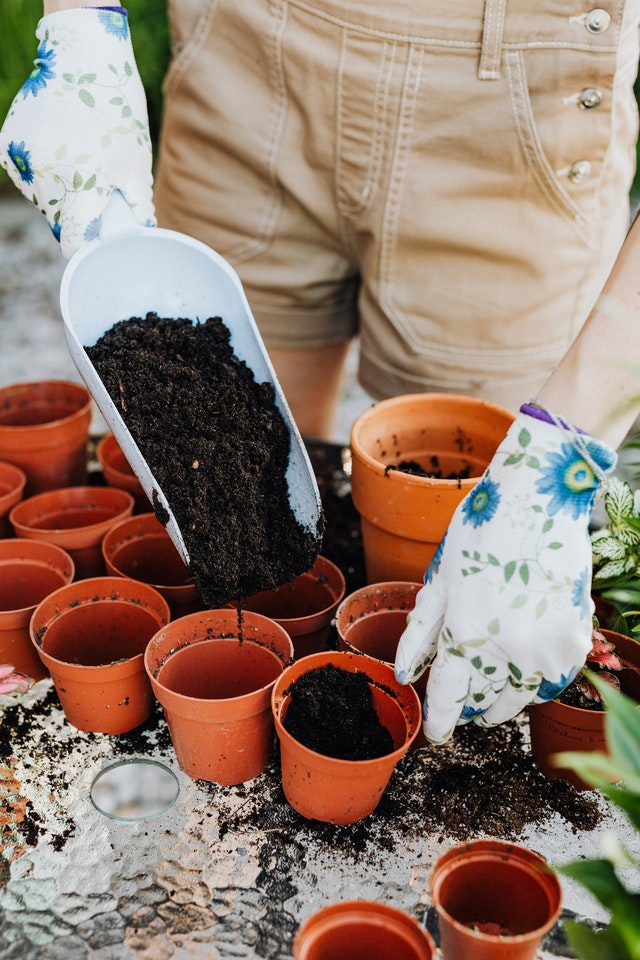Do you know that feeling of waking up after a good cup of coffee? Well, the same can be done with your garden; the whole breakfast can work as compost, so before throwing away the leftover fruit or waste from the prepared coffee, think that you can reuse it and help your garden to be healthier, and the best, organically!
This drink of the gods not only gives you the energy you need to start a new day, but now it will also be your ally to fertilize plants and even create a natural pesticide. Follow this guide to learn about all the benefits.
Benefits of Coffee on Soil

Unlike the coffee we are used to drinking, caffeine is not what stimulates the garden, but the multiple minerals, phosphorus, potassium, and nitrogen it contains. Contrary to synthetic fertilizers, coffee grounds slowly release these nutrients, giving the soil a chance to absorb them over a long period of time, ensuring a healthy lawn year-round.
In addition, coffee contributes to microorganisms that enhance plant growth and attracts earthworms, which are responsible for aerating and oxygenating the soil. Fertilizing regularly with vegetable compost, mixing the coffee with the soil and the rest of the organic compost can completely reduce the need for conventional fertilizer.
Contrary to freshly roasted coffee beans which are very acidic, coffee grounds that have already been used have a neutral PH, so to be a successful fertilizer we need the coffee to have been infused first.
How to Prepare Your Coffee Fertilizer?
The first thing you have to know is that when it comes to storing coffee leftovers, you must make sure that they are completely dry. For this, you will need an aluminum tray and some newspaper spread inside it. Every morning when you clean your coffee maker, discard the coffee remains in the tray and place it in the sun to ensure proper drying, this will prevent your coffee remains from rotting or fungus growth, which would ruin your compost.
Then transfer to a glass, plastic, or other types of Tupperware container. Pro Tip: You can store it in a regular water jug (like a water jug) and “wash” your lawn with coffee so you can use it regularly and evenly.
Now pour your coffee compost around the root of each plant and stir the soil a bit so that it adheres much better to the soil. Due to its natural properties, this fertilizer is ideal for plants such as roses, blueberries, strawberries, strawberries, azaleas, hydrangeas, or rhododendrons.
Coffee Grounds to Make Compost or Manure
The coffee remains have two main functions when adding them to the compost for the soil of our garden, orchard, or potted plants:
Enriches the soil: composting regularly by mixing the coffee with the soil and vegetable mulch can reduce the need for conventional compost, and even make it unnecessary. The result is a fertilizer that does not over-acidify the soil and behaves like an organic fertilizer that is somewhat alkaline. To make liquid fertilizer, mix it with water and let it sit overnight. Using mulch to pour coffee grounds directly around plants is also effective, whether in pots or large gardens.
Nitrogenize the soil: although nitrogen fertilizer alludes to a chemical element, at least if we look at its conventional definition, it is also true that the coffee we drink derives from processed seeds, so coffee grounds are rich in nitrogen. About 10% of it is ideal for enriching the soil with nitrogen. This is a great help for plant growth, flowering, and garden fruit (if any).
Therefore, coffee can be added to the compost. Because coffee grounds are a nitrogen source, it is considered a brown-green compost material ideal for adding plant debris and mowing grass. Active composting is required. Most experts recommend using this ingredient with a small amount of coffee. You need to know that coffee grounds should not contain more than 20% compost. Doing so may have adverse effects.
If you wish, you can also add coffee grounds to your compost to make sure your plants are growing. Of course, this treatment is not recommended because coffee is not cheap and can be too expensive.
If you’re tired of throwing away coffee grounds every morning after drinking coffee, consider using nutritious coffee grounds for gardening. The natural acid content of coffee neutralizes the alkaline soil and supplies essential elements such as nitrogen and potassium to the soil. With more creativity, coffee grounds can be used in different ways in your garden.
Use Coffee Grounds in Your Garden

1: Use Coffee Grounds as Compost.
The easiest way to use leftover coffee grounds is to use them as part of your compost. Using organic coffee grounds can speed up the decomposition of compost. Add the remaining coffee grounds to the compost, mix well, and use it easily.
Compost is divided into “green” compost and “brown” compost. The moist, nutritious coffee grounds are classified as “green” compost. If you’re using too much coffee grounds as compost, balance it out by adding dry, bulky “brown” compost, such as dry leaves, twigs, newspaper, straw, corn husks, or sawdust.
2: Apply Coffee Grounds Directly Into the Soil to Increase Acidity.
Coffee itself has a pH of about 5.1, so it has higher acidity than most garden soils. It may not be suitable for some plants, but it is perfect for plants that require strong acidity. As the growing season approaches, use your finger to gently sprinkle coffee grounds near the roots. In the case of blueberries, cranberries, and citrus fruits, it is best to mix ground coffee products. This section also includes Camellia, Cardinia, and Rhododendron.
Some plants produce flowers of different colors when the soil is acidic. For example, adding the coffee powder to a hydrangea allows it to produce blue flowers.
3: Try Adding Lime to Adjust the Ph of Your Coffee.
As noted above, the naturally acidic content of coffee grounds is not suitable for most plants in the garden. To control this, add a small amount of lime to the coffee grounds. Lime is alkaline (or neutral rather than acidic), so it can be used to neutralize the acidity of ground coffee. Use the limed coffee grounds as a nutrient or mulch for the soil.
Lime (usually sold as “garden lime” or “agricultural lime”) comes in powder form. It can be purchased relatively inexpensively at any garden supply store or hardware store.
You can also use wood ash instead of lime. Wood ash also acts as an acidifier, thus neutralizing the acid content of the soil or coffee grounds. Wood ash is also rich in nutrients such as potassium and phosphorus.
4: Using Coffee Grounds to Provide Nutrients to the Soil.
Coffee grounds aren’t the only thing that can be used as an acid supply. It also contains several nutrients that are important for growing healthy plants. If the soil lacks nutrients, refer to the following ingredients and add coffee grounds to supplement the nutrients:
Ingredients found in large quantities in coffee grounds:
- nitrogen
- magnesium
- potassium
- Ingredients that are rarely present in coffee grounds:
- sign
- calcium
5: Try Making a Nutrient Solution.
In addition to spraying coffee grounds in your garden, you can use the coffee grounds to create a nutrient solution that can feed your plants. Dissolve the coffee grounds in a bucket of water and leave it in an inconspicuous place, such as a garage, for a day or two. After some time, a yellowish liquid is formed. Filter the coffee groundswell and spray the liquid over the garden.
Since this nutrient solution contains nutrients and acids like regular coffee grounds, care should be taken when used on plants that do not require strong acids, nitrogen, or potassium.
Using Coffee Grounds as an Alternative

1: Use Coffee Grounds to Control Parasites.
Vegetative snails don’t like coffee grounds, so sprinkle coffee grounds with your finger around the plants you want to protect. If you are concerned about the acidity of the soil, spray the coffee grounds in circles and place them as far away from the plant stems as possible.
- The caffeine content of coffee grounds is known to prevent parasites.
1: Use Coffee Grounds to Control Parasites.
In addition to small parasites, coffee grounds are also effective at deterring cat friends. To prevent cat intrusion, sprinkle coffee grounds around the plant, the same as when snail access was suppressed. However, depending on the amount used, the acidity of the soil may increase.
3: Use Coffee Grounds as Food for Bugs.
If you are farming earthworms, coffee grounds can be a great tool. Earthworms love coffee powder, so add enough coffee powder to the compost where the worms live. However, you must use the coffee grounds in a balanced way. Be sure to add not only the coffee grounds but also newspapers, leaves, and pieces of fruit or vegetables.
4: Use Coffee Grounds to Control Fungal Infections.
There is some evidence that coffee grounds are useful in fighting fungal infections in plants. Lightly sprinkle coffee grounds to prevent plant counterfeiting, root rot, and sclerotia. Tomatoes, eggplants, and peppers are particularly susceptible to fungal infections, so coffee grounds can be very useful.


